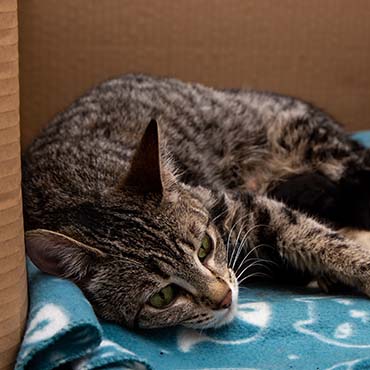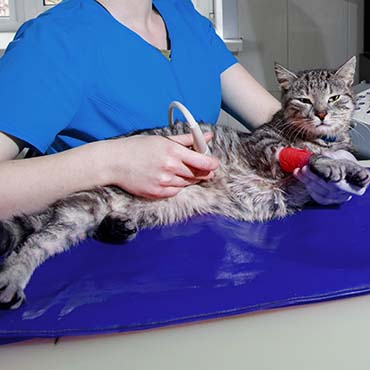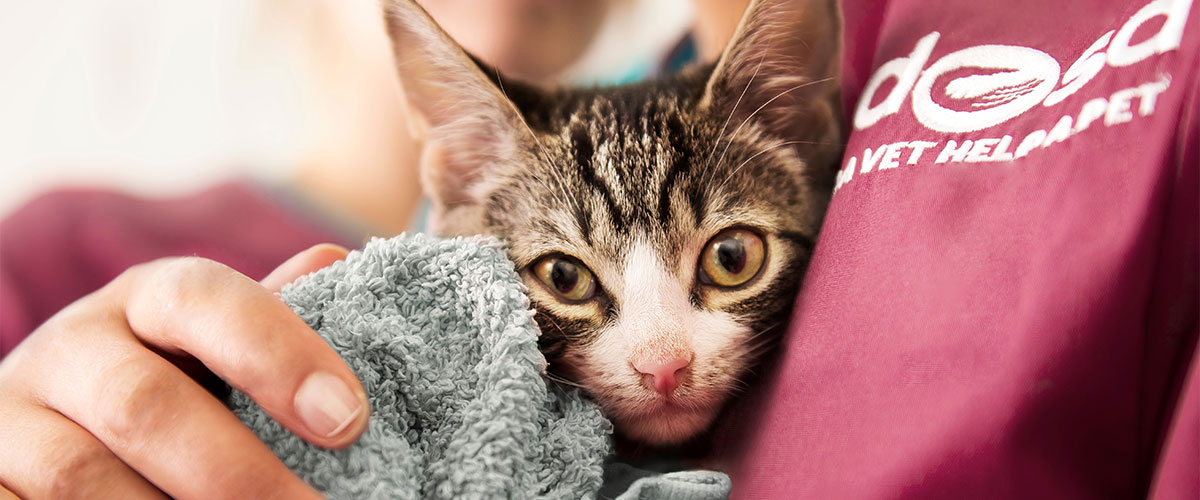Cat labour – a guide to your cat giving birth
Overview
- If you have a pregnant cat, it’s important to know how to look after her and prepare for her kittening well in advance.
- If your cat is having trouble giving birth, call your vet immediately.
- PDSA vets recommend neutering your cat at 4 months old (before their first season) to reduce the chance of an unwanted pregnancy.
Preparing for kittening
Preparing for your cat's labour will make problems much less likely. You will need to consider the following:
Due date
Make a note of your cat's due date (63-68 days after mating).
Kittening box
Prepare a box for your cat to give birth in well in advance of her due date. You can buy a disposable, self-assembly box, or make one yourself (a large cardboard box will do). The box needs to be:
- Comfortable, warm and in a quiet room that’s kept at around 22°C
- Big enough for your cat to comfortably stand, fully stretch and turn around in (open top is ideal)
- Lined with an absorbent bedding material (i.e. towels/bedding)
- High enough to contain crawling, newborn kittens
Vet Help
Have your vet’s telephone number handy in case you need any help or advice.
Feeding, worming and general care
Make sure your cat is fed and dewormed correctly during her pregnancy.

Prepare a basket or box for your cat to have her kittens in.
Normal kittening
Preparation for birth
As your cat prepares to give birth her birth canal will relax and widen, while her kittens turn around into the correct position for birth. During this stage, (which often lasts between 6-12 hours), you will notice your cat’s behaviour changing. Signs often include:
- Becoming restless and vocal
- Hiding away
- Grooming excessively (especially around her vulva)
- Panting
- Eating less
- Passing a small amount of red/brown mucus from her vulva
- ‘Nesting’ - scratching and pacing around her kittening box
Just before your cat starts having her kittens, she is likely to start settling down (ideally in her kittening box, but don’t worry if it’s somewhere else).
Giving birth
Once your cat’s starts to give birth, strong contractions and straining will begin.
- The first kitten is normally born within 30 minutes of straining starting, and following kittens should come every 10-60 minutes.
- Kittens are normally born inside a thin sac, which your cat should tear off, enabling them to breath.
- For each kitten born, your cat will also pass an afterbirth (placenta). They usually come approximately 15 minutes after each kitten, but don’t always come in perfect order (i.e. a few kittens may be born before their placentas are passed). If possible, count the placentas as they are passed so you can inform your vet if one has been left behind (an infection risk).
- Both head first and tail first kittening is normal (tail first may take a little longer).
- Between each kitten, your cat should seem comfortable, lick and feed her newborn.
- It usually takes 4-16 hours for all kittens to be born, but it can take longer.
- WARNING: contact your vet if your cat has been straining for 20-30 minutes without producing a kitten, is crying out in pain, or you are concerned at any point.
After giving birth
After giving birth, your cat is likely to be very hungry, tired and need to rest. She will need to stay with her kittens to feed and bond with them. Make sure they are in a quiet space, free from noise and disturbance. There is a risk that your cat may reject her kittens if she doesn’t feel comfortable, relaxed and able to bond with them after giving birth. It’s perfectly normal for her to have a vaginal discharge for a few weeks after giving birth but it should not smell. Contact your vet if you are worried.
Problems kittening/when to contact your vet
Fortunately, cats tend to have a lot fewer problems than dogs when giving birth to their young, but, it's still important to monitor them carefully because occasionally problems do arise, especially in flat-faced breeds such as Persians. Contact your vet if you notice any of the following problems:
Green discharge
If you see a green discharge coming from your cat’s vulva, it could mean that a kitten is in distress (their blood and oxygen supply is falling).
Bleeding
It's perfectly normal to see some blood during your cat's kittening, but anything more than a few drips is abnormal and should be checked immediately by your vet.
Exhaustion
If your cat’s labour continues for a long time, she may become exhausted and stop straining.
Straining but no kittens
Contact your vet urgently if your cat has been straining for 20-30 minutes without producing a kitten, there may be a blockage.
Kitten stuck
Large or deformed kittens can become stuck in the pelvis. Sometimes they come halfway and sometimes they don’t even get that far. If your cat has a kitten stuck inside her, call your vet for advice immediately, do not pull the kitten.
Sac problems
Some first time mums need help removing the sac from their kittens. Give your cat a chance to remove the sac themselves by putting the kitten in front of them, but tear a small hole in the sac and remove it yourself if they don’t act. If the sac stays around the kittens face for too long, they won’t be able to breathe. If you’re unsure about how to do this, call your vet immediately for advice.
Umbilical cord problems
First time mothers may need help removing their kittens’ umbilical cords. Umbilical cords don’t need to be removed straight away but, if they stay attached for too long they can cause problems and injuries. Call your vet for advice about how to tie umbilical cords.
No kittens
If your cat hasn’t shown any signs of going into labour a few days after you expected her to, contact your vet.
Stillborn kittens
Have your cat checked if any of her kittens are born dead.
Poorly mother
Have your cat checked if she seems unwell, or just 'not herself' before, during or after kittening.
Dystocia (problems giving birth)
If your cat is having trouble giving birth, contact your vet straight away and try to give as much detail about your cat and her pregnancy as possible. Your vet may want to do the following:
- An X-ray or scan: to check the womb and unborn kittens.
- Monitor: depending how your cat appears, your vet may decide to keep her in the hospital for monitoring and wait to see what happens. They will check her regularly and take further action if necessary.
- Medication: to help the womb contract more forcefully.
- A caesarean: this involves a general anaesthetic and surgery to remove the kittens.

Your vet may scan to check the womb and unborn kittens.
- How long is a cat pregnant for?
- What should I do if my cat is having problems kittening?
- What are the risks of kittening?
- Should I let my cat have kittens?
How long is a cat pregnant for?
Pregnancy normally lasts between 63-68 days, but it can vary by a few days.
What should I do if my cat is having problems kittening?
Always ring your vet, they will give you advice and tell you if any intervention is needed.
What are the risks of kittening?
It’s rare for a cat to have problems kittening, but issues do occasionally arise. In the worst-case scenario, if severe problems develop, your cat and her kittens could die. Contact your vet immediately if you notice any problems while your cat is giving birth.
Should I let my cat have kittens?
Your cat doesn’t need to have kittens to live a normal healthy life, and there is an abundance of kittens and cats in rescue centres across the UK. PDSA recommends neutering before the first season to avoid unwanted pregnancies, especially if you’re worried about dealing with the birth and finding homes for the kittens.
Published: January 2021
Did you find this page useful?
Tell us more
Please note, our vets and nurses are unable to respond to questions via this form. If you are concerned about your pet’s health, please contact your vet directly.
Thank you for your feedback
Want to hear more about PDSA and get pet care tips from our vet experts?
Sign up to our e-newsletter
Written by vets and vet nurses. This advice is for UK pets only. Illustrations by Samantha Elmhurst.

